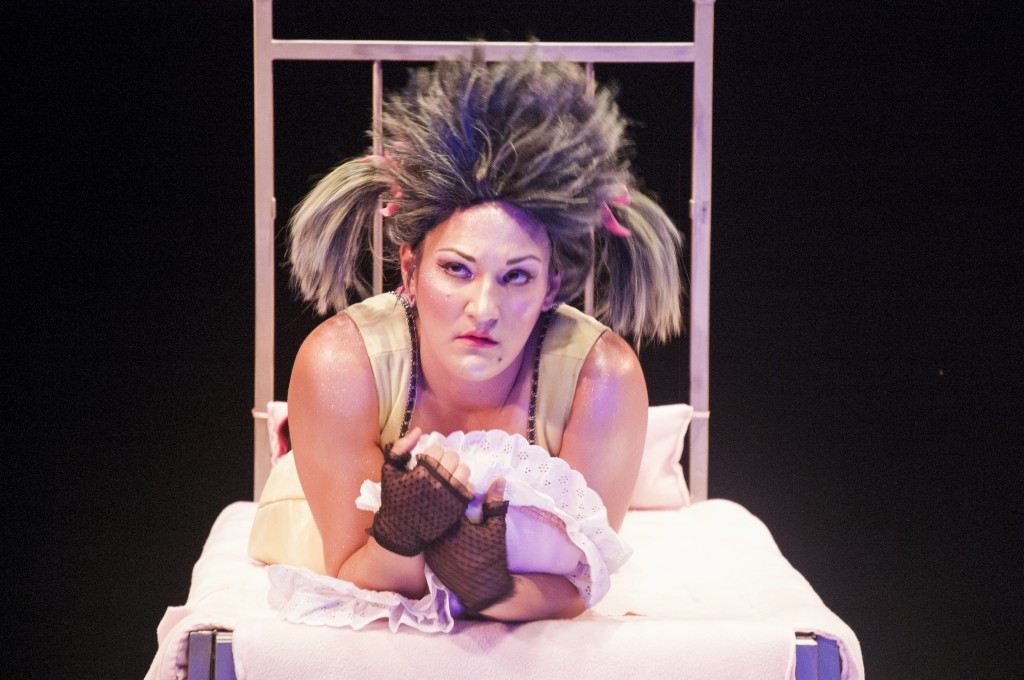
After weeks of waiting, and near hysterical sobs from the opera lovers unable to get tickets to the opening show, I made my way to the Berkeley Theatre on Friday to see Tapestry Opera’s season closer, Juliet Palmer’s Shelter. This isn’t a great space for opera; its acoustics are about as successful as a game of Texas hold’em with toddlers, and just as loud. But the intimacy of the theatre is undeniable, and it’s always exhilarating to feel the draft of air blow past you as the singers move across the stage. Opera at close range.
Toronto composer Juliet Palmer has a long history of skirting convention, and is by all intents a truly contemporary composer. She doesn’t shy away from exploring new forms, be they an a cappella sowing-machine opera (Stitch – 2008), or an all-female boxing opera, (Voice-Box – 2010). In many ways her work is akin to the visual arts, where repetition is creative insertion, and the materials are just as telling as the form.
Shelter, the newest in Palmer’s growing stage arsenal, is a bizarre tale about a family’s quest for normalcy in a surreal cartoon-like 1950s suburb. Its plot is tied together with the Austrian Jewish physicist Lise Meintner, one of the discoverers of nuclear fission, who was forced to flee Germany during WWII. So… what happens when a nuclear physicist and a nuclear family meet? Easy – a nuclear baby, which, to the dismay of the family, glows.
In a plot reminiscent of a 1990’s Douglas Coupland novel, it owes its allegorical weirdness to Julie Salverson, who pondered on it for nearly 10 years before finally presenting it (in all its nuclear glory) to an Edmonton audience in 2012.
But unlike Coupland’s timely ‘fear the sun’ dystopia, Shelter’s narrative comes across like an outdated re-telling of a story of a story. Potentially meaningful archetypes of a dysfunctional nuclear family are instead treated as smarmy annotations that skirt the surface as style over substance. Racing towards an apocalyptic finish, Shelter quickly falls apart, dissolving into structural incoherence and wild improbability.
The cast did its best with the befuddling material. In particular, Andrea Ludwig’s performance of Lise Meitner was very strong. Her voice was clear with character and resolve. Christine Duncan played the role of the baby-mama, Claire, had incredible range, and her no-holds bared shifts between jazz and opera styles were praiseworthy. Andrew Love’s depiction of the husband Thomas could have been hammy in less capable hands, but he also did a fine job. Keith Klassen, who played the Pilot, looked like he stepped right out of a WWII bomber, and his tenor voice countered the other principals well.
Hope, the glowing baby who inexplicably turns 21 at one point, is played by Teiya Kasahara. Hers is a powerful voice that was unfortunately mic’ed for an entire scene, blowing off our eardrums from a seemingly never-ending panorama atop a crib turned bed. Despite the microphone gaffe, no fault of her own, she played the role with a fantastic spirit that made me lament the fact that the character was dimensionally droll.
To contribute to the whimsical performance, the stage projections by Ben Chaisson and Beth Kates were stunning. The central feature was a large moon, which functioned as a canvas that included the celestial nighttime sky, physics equations, and live-drawn fanciful cartoon houses. The stage design included similar houses by Sue LePage that lined the stage, providing a suburban bungalow parameter.
The ensemble, carefully led by Music Director, Leslie Dala, was elbowed to the left of the stage, and featured a house band of both electric and acoustic instruments. They performed Palmer’s music matter of fact, and the lone violin sounded weak compared to the beef of the electric guitar and bass. I suspect this was due to the fact that it was pointing towards a curtain-lined wall, which sucked up the sound like a tall glass of water on a hot summer day.
Palmer’s score was creative, though it suffered under the weight of the verbose libretto, and offered little room for anything to befriend it. I kept hoping for a moment of pause, a moment to allow the characters and music to just be, without such hammering out.
Despite the miss, I admire the risk, and it is important to acknowledge that not all new operas can be poised to enter the “great new works” category. Operas that fail are important because they speak to what works, and offer clues to what doesn’t. The performances were great, the music was very clever and fun, but neither was able to save the grace of the premise. But as the adage goes, nothing of great significance is achieved by playing it safe, and I look forward to the next production by Palmer, which judging from her past work, will be worth the risk.
Michael Vincent
- THE SCOOP | Royal Conservatory’s Dr. Peter Simon Awarded The Order Of Ontario - January 2, 2024
- THE SCOOP | Order of Canada Appointees Announced, Including Big Names From The Arts - December 29, 2023
- Ludwig Van Is Being Acquired By ZoomerMedia - June 12, 2023



